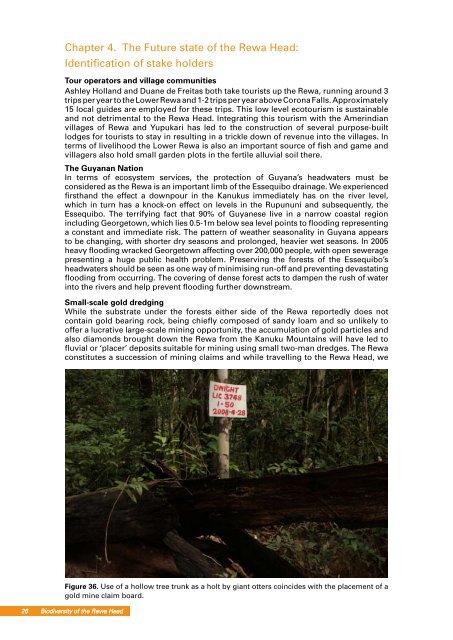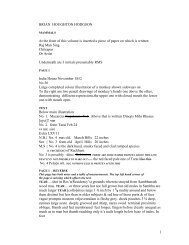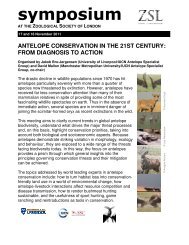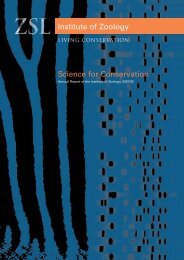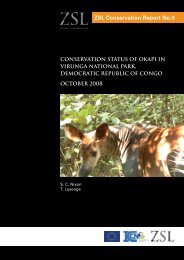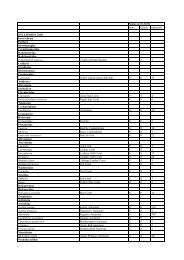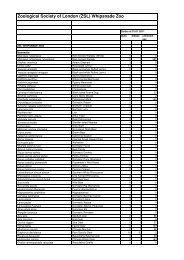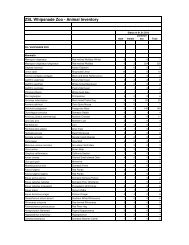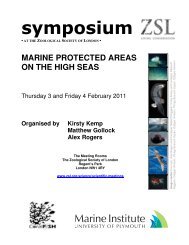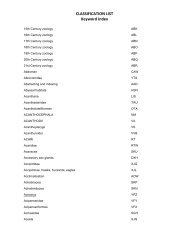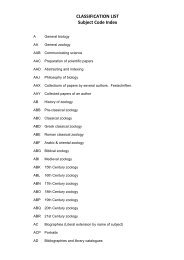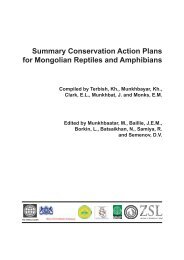Biodiversity of the Rewa Head B Zoological Society of London ...
Biodiversity of the Rewa Head B Zoological Society of London ...
Biodiversity of the Rewa Head B Zoological Society of London ...
Create successful ePaper yourself
Turn your PDF publications into a flip-book with our unique Google optimized e-Paper software.
Chapter 4. The Future state <strong>of</strong> <strong>the</strong> <strong>Rewa</strong> <strong>Head</strong>:<br />
Identification <strong>of</strong> stake holders<br />
Tour operators and village communities<br />
Ashley Holland and Duane de Freitas both take tourists up <strong>the</strong> <strong>Rewa</strong>, running around 3<br />
trips per year to <strong>the</strong> Lower <strong>Rewa</strong> and 1-2 trips per year above Corona Falls. Approximately<br />
15 local guides are employed for <strong>the</strong>se trips. This low level ecotourism is sustainable<br />
and not detrimental to <strong>the</strong> <strong>Rewa</strong> <strong>Head</strong>. Integrating this tourism with <strong>the</strong> Amerindian<br />
villages <strong>of</strong> <strong>Rewa</strong> and Yupukari has led to <strong>the</strong> construction <strong>of</strong> several purpose-built<br />
lodges for tourists to stay in resulting in a trickle down <strong>of</strong> revenue into <strong>the</strong> villages. In<br />
terms <strong>of</strong> livelihood <strong>the</strong> Lower <strong>Rewa</strong> is also an important source <strong>of</strong> fish and game and<br />
villagers also hold small garden plots in <strong>the</strong> fertile alluvial soil <strong>the</strong>re.<br />
The Guyanan Nation<br />
In terms <strong>of</strong> ecosystem services, <strong>the</strong> protection <strong>of</strong> Guyana’s headwaters must be<br />
considered as <strong>the</strong> <strong>Rewa</strong> is an important limb <strong>of</strong> <strong>the</strong> Essequibo drainage. We experienced<br />
firsthand <strong>the</strong> effect a downpour in <strong>the</strong> Kanukus immediately has on <strong>the</strong> river level,<br />
which in turn has a knock-on effect on levels in <strong>the</strong> Rupununi and subsequently, <strong>the</strong><br />
Essequibo. The terrifying fact that 90% <strong>of</strong> Guyanese live in a narrow coastal region<br />
including Georgetown, which lies 0.5-1m below sea level points to flooding representing<br />
a constant and immediate risk. The pattern <strong>of</strong> wea<strong>the</strong>r seasonality in Guyana appears<br />
to be changing, with shorter dry seasons and prolonged, heavier wet seasons. In 2005<br />
heavy flooding wracked Georgetown affecting over 200,000 people, with open sewerage<br />
presenting a huge public health problem. Preserving <strong>the</strong> forests <strong>of</strong> <strong>the</strong> Essequibo’s<br />
headwaters should be seen as one way <strong>of</strong> minimising run-<strong>of</strong>f and preventing devastating<br />
flooding from occurring. The covering <strong>of</strong> dense forest acts to dampen <strong>the</strong> rush <strong>of</strong> water<br />
into <strong>the</strong> rivers and help prevent flooding fur<strong>the</strong>r downstream.<br />
Small-scale gold dredging<br />
While <strong>the</strong> substrate under <strong>the</strong> forests ei<strong>the</strong>r side <strong>of</strong> <strong>the</strong> <strong>Rewa</strong> reportedly does not<br />
contain gold bearing rock, being chiefly composed <strong>of</strong> sandy loam and so unlikely to<br />
<strong>of</strong>fer a lucrative large-scale mining opportunity, <strong>the</strong> accumulation <strong>of</strong> gold particles and<br />
also diamonds brought down <strong>the</strong> <strong>Rewa</strong> from <strong>the</strong> Kanuku Mountains will have led to<br />
fluvial or ‘placer’ deposits suitable for mining using small two-man dredges. The <strong>Rewa</strong><br />
constitutes a succession <strong>of</strong> mining claims and while travelling to <strong>the</strong> <strong>Rewa</strong> <strong>Head</strong>, we<br />
Figure 36. Use <strong>of</strong> a hollow tree trunk as a holt by giant otters coincides with <strong>the</strong> placement <strong>of</strong> a<br />
gold mine claim board.<br />
26 <strong>Biodiversity</strong> <strong>of</strong> <strong>the</strong> <strong>Rewa</strong> <strong>Head</strong>


